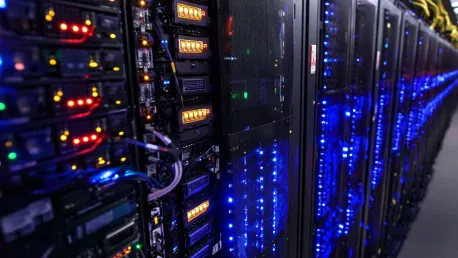The rapid growth of artificial intelligence (AI) is reshaping industries at an unprecedented pace, placing significant demands on data center infrastructure. As AI technologies become increasingly integrated into everyday applications, data centers worldwide are evolving to handle these intensive workloads while also prioritizing sustainability. This article delves into the transformative steps being taken by leading technology suppliers and companies to create AI-ready, sustainable data centers.
Infrastructure Upgrades and Strategic Investments
The exponential rise of AI applications is pushing companies to expand and enhance their data center capabilities. To keep up with the computational and storage requirements, major technology firms are making substantial investments. Companies like Singtel, Hitachi, Intel, and Oracle are at the forefront of these upgrades, each committing large sums to develop sophisticated data center infrastructures.
These investments are focused on building advanced architectures and integrating state-of-the-art resources. For example, Oracle’s development of one of the world’s largest AI supercomputers within its Oracle Cloud Infrastructure (OCI) embodies the efforts to meet the AI-driven demands. Such infrastructure not only supports high-performance computing but also offers flexible deployment options suitable for diverse AI applications.
The surge in AI deployments is also reflected in the financial markets. Reports indicate a significant increase in server and storage system component revenues, particularly for components like AI accelerators and GPUs. This escalating demand underscores the crucial role of these technologies in AI-driven data center upgrades. As the industry invests in these vital components, the capacity and capability of data centers to support complex AI tasks will continue to grow, paving the way for future innovations.
The Surge in AI Accelerators and GPUs
Fueling these infrastructure enhancements is the skyrocketing demand for AI accelerators and GPUs, essential for managing the heavy computational loads of AI applications. A report by the Dell’Oro Group highlighted a 127% year-over-year surge in revenue from these components during Q2 2024, indicating the rapid pace at which AI technologies are being adopted.
The price spikes for memory components and storage drives further indicate the growing reliance on advanced hardware to support AI workloads. This trend is evident across various sectors, from tech giants developing AI-driven consumer products to enterprises leveraging AI for data analysis and decision-making. The inclusion of high-performance GPUs and accelerators is indispensable for modern data centers aiming to maintain relevance in a fast-paced technological landscape.
Such substantial growth in hardware demand is a testament to the pressing need for efficient and powerful computing solutions. Companies are increasingly prioritizing the procurement of high-performance components to ensure their data centers can seamlessly handle the intensive demands of AI applications. As organizations continue to expand their AI initiatives, the emphasis on cutting-edge hardware will likely become more pronounced, driving further innovation and efficiency in data center operations.
Emphasizing Sustainability in AI-Ready Data Centers
As the energy requirements for AI workloads increase, the focus on sustainability within data centers has never been more critical. Leading firms are innovating to balance performance with environmental responsibility, integrating energy-efficient solutions and green technologies.
Singtel and Hitachi, for instance, are developing data centers that utilize green energy sources and intelligent cooling technologies. These efforts aim to minimize the environmental footprint of AI operations while maintaining high efficiency. By leveraging renewable energy and advanced cooling methods, companies can mitigate the adverse ecological impacts of their data centers.
Intel and Oracle are also making notable strides in this area. Both companies are optimizing their hardware designs to enhance performance per watt, aiming to reduce the thermal footprint of AI infrastructures. Such initiatives exemplify the industry’s commitment to merging technological advancement with sustainability. As the push for greener data centers intensifies, these efforts demonstrate the feasibility of achieving high computational power without sacrificing environmental considerations.
Oracle’s Groundbreaking AI Supercomputing Efforts
Oracle has emerged as a leader in the deployment of AI-friendly infrastructure. The creation of a massive AI supercomputer within Oracle Cloud Infrastructure (OCI) illustrates the push toward scalable, high-performance AI capabilities. Powered by NVIDIA’s Blackwell AI accelerator platform, Oracle’s zettascale clusters are engineered to support intensive AI workloads with ultra-low latency networking and robust storage solutions.
These developments allow Oracle to cater to a wide range of AI-driven applications, from advanced language models to AI-powered personal assistants. Such versatility in deployment options is crucial for addressing the varied needs of different industries, further solidifying Oracle’s position in the AI infrastructure space.
Oracle’s endeavors highlight the critical integration of high-speed, low-latency networks and specialized storage solutions, which are essential for managing the large data sets typical of AI applications. This approach ensures that Oracle can provide efficient, flexible, and scalable AI infrastructure to meet the growing demands of the industry. By focusing on such cutting-edge solutions, Oracle showcases its commitment to leading the charge in AI supercomputing.
Intel’s Innovations in AI Processing
Intel’s introduction of Xeon 6 processors and Gaudi 3 AI accelerators marks significant progress in AI hardware. The Xeon 6 processors are designed to handle general-purpose workloads efficiently, while Gaudi 3 is tailored for deep learning applications, offering enhanced memory bandwidth and compatibility with popular AI frameworks like PyTorch.
These processors aim to deliver superior performance per watt, addressing both the computational and energy efficiency needs of modern AI deployments. Intel’s dual focus on general-purpose and specialized AI processing highlights its comprehensive strategy to support the broad spectrum of AI applications. By equipping data centers with these advanced processors, Intel enables smoother, more efficient handling of complex AI tasks.
By providing scalable and cost-effective solutions, Intel ensures that its users can deploy AI technologies without compromising on performance or sustainability. This approach supports a more inclusive adoption of AI, enabling even smaller enterprises to integrate advanced AI capabilities into their operations. As the adoption of AI grows, Intel’s cutting-edge solutions will play a vital role in driving this technological evolution.
Cerebras Systems’ Revolutionary Approach
Cerebras Systems has positioned itself at the forefront of AI processing innovation with its CS-3 system, featuring the Wafer Scale Engine-3 (WSE-3). This system delivers significant improvements in AI inference performance and energy efficiency compared to traditional GPUs, showcasing Cerebras’ commitment to redefining the hardware capabilities available for AI applications.
The company’s API and software ecosystem are designed to ensure seamless integration and migration of AI models, providing users with substantial performance enhancements regardless of their specific use cases. By offering a highly scalable and efficient solution, Cerebras addresses the needs of diverse users, from startups embarking on their AI journeys to established enterprises requiring significant computational power.
Cerebras’ API allows for seamless migration and performance enhancements for AI models, catering to varied use cases from start-ups to large enterprises. This ease of integration ensures that AI researchers and developers can focus on their core work without being bogged down by compatibility issues or inefficiencies in hardware utilization. Cerebras’ innovative approach to AI processing positions the company as a significant disruptor in the AI infrastructure space.
Growth in the Asia-Pacific Region
The Asia-Pacific region, particularly Japan, is experiencing rapid data center market expansion to meet AI and cloud service demands. Singtel and Hitachi are collaborating to develop AI-ready, sustainable infrastructure in this region, leveraging green power systems and smart data management solutions.
The growing appetite for AI and cloud services in the Asia-Pacific region presents significant opportunities for data center development. Companies like Singtel and Hitachi are spearheading these efforts by deploying advanced, environmentally friendly technologies tailored to the region’s specific needs. These developments not only support local AI initiatives but also contribute to global sustainability goals.
As the demand for AI and cloud services continues to rise, the focus on creating future-ready, sustainable data centers in high-growth markets will become increasingly important. The collaborative efforts between leading technology suppliers ensure that these regions can achieve the necessary infrastructure advancements while maintaining a strong commitment to sustainability, ultimately driving innovation and economic growth across the globe.
The article paints a vibrant picture of the AI-driven evolution of data center infrastructure. At its core, the narrative revolves around the balance between meeting the computational demands of AI technologies and maintaining sustainable operations. Major technology suppliers are racing to develop AI-ready, scalable, and environmentally friendly data centers, with significant investments from giants like Singtel, Hitachi, Intel, and Oracle demonstrating their commitment to this balance.
Sustainability emerged as a crucial theme throughout the article. As AI workloads grew, so did energy requirements, pushing companies to innovate in green power technologies and efficient cooling solutions. Singtel’s partnership with Hitachi, for instance, spotlighted the integration of green energy systems with AI infrastructure.
Oracle’s OCI represents a monumental leap in AI supercomputing, highlighting the move towards flexible, high-performance computing environments capable of supporting diverse and intensive AI applications. Oracle’s integration with NVIDIA’s Blackwell AI accelerators underpinned this strategic focus on performance and sustainability.
Intel’s Xeon 6 and Gaudi 3 processors reflected a dual approach: enhancing general-purpose workloads and deep learning capabilities, providing scalable and cost-efficient solutions for the hyperscale cloud user base.
Cerebras Systems’ innovation with the CS-3 and its Wafer Scale Engine-3 emphasized efficiency in AI inference, positioning the company as a disruptor in the AI infrastructure space. Their focus on providing easily accessible, high-performance AI services catered to a broad range of users from individual developers to large enterprises.
Regional growth, particularly in the Asia-Pacific, was an emerging trend, with countries like Japan poised to see significant data center expansion. The collaboration between Singtel and Hitachi was a testament to the strategic focus on creating AI-ready, sustainable infrastructure in high-growth markets.
Consolidated Conclusion
The exponential rise of artificial intelligence (AI) is revolutionizing industries at an unprecedented speed, challenging data center infrastructures to keep up. As AI technology seamlessly integrates into everyday applications, data centers around the globe are evolving to support these demanding workloads. This evolution is not just about enhanced performance but also emphasizes sustainability.
With AI’s demands growing, data centers need more than just powerful processors; they need advanced cooling systems, efficient power management, and better data storage solutions. Leading technology providers and companies are taking significant steps to develop AI-ready data centers that are sustainable and environmentally friendly. This includes utilizing renewable energy sources, optimizing energy efficiency, and implementing strategies to minimize carbon footprints.
In adapting to AI’s requirements, the industry is also prioritizing flexibility and scalability. Data centers must now handle immense amounts of data while ensuring they can scale up or down as needed. Innovative designs and cutting-edge technologies are being employed to strike a balance between performance and sustainability. This transformation is essential as AI continues to shape the future, pushing companies to invest in infrastructure that can support both advanced AI workloads and environmental responsibility.









